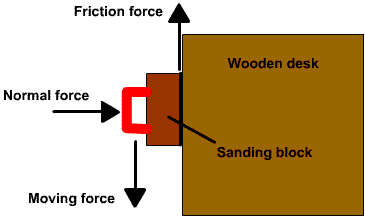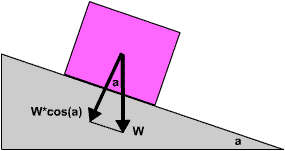|
The standard friction equation is the
relationship between the resistive force of sliding
friction for hard surfaces, the normal force pushing the
two surfaces together and the coefficient of friction
number for the two surfaces. When applied to sliding
friction of hard surfaces, the equation implies that
friction is independent of the area of the surfaces in
contact. This equation can also apply to soft surfaces,
rolling friction and fluid friction, but the coefficient
of friction may depend on area, shape and viscosity
factors.
Questions you may have include:
-
What is the standard friction
equation?
-
What is the normal force?
-
What is the coefficient of friction?
Standard friction equation
The standard equation for determining
the resistive force of friction when trying to slide two
solid objects together states that the force of friction
equals the coefficient friction times the normal force
pushing the two objects together. This equation is
written as:
Fr = μ*N
where
Fr is the resistive force of
friction,
μ is the coefficient of friction
for the two surfaces (Greek letter "mu"), and
N is the normal or perpendicular
force pushing the two objects together.
Fr and N are measured in
units of force, which are pounds or newtons. μ is a
number between 0 (zero) and ∞ (infinity).
This equation applies to both static and
kinetic sliding friction. Static friction is the
friction before an object starts to slide. Kinetic
friction is the friction when the object is actually
moving or sliding.
Static friction and kinetic friction
have different coefficient of friction values.
An interesting result of this equation
is that in the case of sliding friction of hard
surfaces, the friction is independent of the area of the
surfaces. In other words, it is just as difficult to
move a 1 square-cm object as a 1 square-meter object, if
they both are pressed to the surface with the same
amount of force. This is not intuitive. You would think that there is
more friction when the surfaces are larger, but the
friction equation states otherwise. You can verify this
fact with experiments. In situations where the surfaces deform or there is
molecular adhesion, the friction is not independent of
the areas in contact. In these cases surface area
usually comes into play. This is also true for rolling
and fluid friction. When solid surfaces are soft and deform or when one
material is a fluid, the shape of the solid object may
be a factor. Although the standard friction equation still holds, the
coefficient of friction may have area, shape and other
factors included in it. Normal force The normal force is the force pushing the two objects
together, perpendicular to their surfaces. For example, if you push a sanding block against a
wooden desk you were sanding, the normal force would be
the amount of force you pushed on the block. You would
move the sanding block in one direction and the force of
friction would be in the opposite direction.

Applying normal force on sanding block and wooden
desk Sometimes, two normal forces are used to cause the
friction. One example is a pair of pliers that applies a normal
force on both sides of a piece of wood that the pair of
pliers is holding. Another example are the calipers on
automobile disc brakes that apply a force on both sides
of the metal disc to slow down the car. The normal force N can be caused by gravity instead of
some applied pressure. This would be in situations where
you slide a heavy object across the floor or some
horizontal surface. Since weight is the force pushing
the objects together, the friction equation becomes:
Fr = μ*W where W is the weight of the object. Thus if a box weighs 100 pounds and the coefficient of
friction between it and the ground is 0.7, then the
force required to push the box along the floor is 70
pounds. Likewise if a box weighs 500 newtons is placed on ice
with a coefficient of friction of only 0.001, then it
would only take 0.5 newtons to move the box. If the weight is on an incline, the normal force will be
reduced by the cosine of the incline angle. N = W*cos(a) where:
N is the normal force on the incline,
W is the weight,
a is the incline angle, and
cos(a) is the cosine of a.

Normal force is weight times cosine of angle Coefficient of friction The coefficient of friction, μ (mu), is a number related
to the two specific surfaces that are in contact with
each other. It is very dependent on the roughness of
each surface and how the materials slide against each
other. Although there are charts listing average values of the
coefficient of friction for various materials, the only
true way to establish the number is by experiment and
testing or empirical measurements. Also, there are no
good formulae or equations to predict μ. By dividing both sides of the standard friction equation
Fr = μ*N by N, you will get the equation:
μ = Fr/N This relationship indicates that if you can measure the
friction force Fr and know the normal force N pushing
the two objects together, you can determine the
coefficient of friction μ. Wide range of numbers The coefficient of friction can range between 0 (zero)
and ∞ (infinity). Close to zero When μ = 0, there is no friction. If μ is close to 0,
there is little friction. For example, leather-soled
shoes on slippery ice has a very small coefficient of
friction, close to zero. That is why you can easily
slide on ice or even take a fall. Even rubber-soled
shoes on ice has a very small coefficient of friction. Close to infinity Many students and teachers mistakenly think that μ must
be less than 1. That is incorrect, since Fr could be
many times the normal force. One extreme example is if you glued an object to
another. The resistance to moving the objects would be
very large and the coefficient of friction would also be
very large. If the glue was so strong that they could
never be slid against each other, then μ would equal
infinity. The reason people think that μ must be less than 1 is
probably since most listing of coefficients of friction
have values less than 1. That is because most materials
of interest usually slide relatively easy on each other. Examples of coefficient The following table shows the coefficient of sliding
friction for a number of materials. Note that the static
coefficient is larger than the kinetic coefficient.
|
|
|
Steel on steel (dry) |
0.6 |
0.4 |
|
Steel on steel (greasy) |
0.1 |
0.05 |
|
Teflon on steel |
0.041 |
0.04 |
|
Brake lining on cast iron |
0.4 |
0.3 |
|
Rubber tires on dry pavement |
0.9 |
0.8 |
|
Metal on ice |
0.022 |
0.02 |
|
Rubber tip of crutch on rough wood |
0.7 |
- |
In the case where a surface is soft, there is molecular
adhesion, and in rolling and fluid friction, the
coefficient of friction is not a simple number. The
coefficient may be dependent on the area of the
surfaces, the amount of deformation, the amount of
adhesion, the shape of the surfaces, the radius of the
wheel or the viscosity of the fluid. What this means is that although the standard friction
equation holds in these cases, the coefficient of
friction will only hold for a specific configuration. In
other words, you can't accurately give something like
the coefficient of rolling friction for a rubber tire on
pavement without stating the type of rubber, area on the
pavement, inflation of the tire, and its tread pattern. The standard friction equation is the relationship
between the resistive force of sliding friction for hard
surfaces, the normal force and the coefficient of
friction for the two surfaces. When applied to sliding
friction of hard surfaces, the equation implies that
friction is independent of the area of the surfaces in
contact. This equation can also apply to soft surfaces,
rolling friction and fluid friction, but the coefficient
of friction may depend on other factors. |